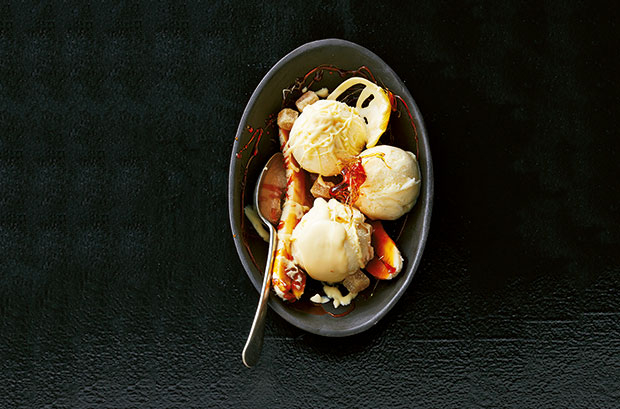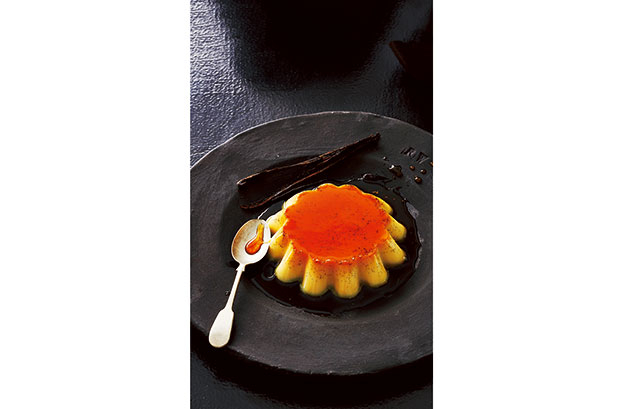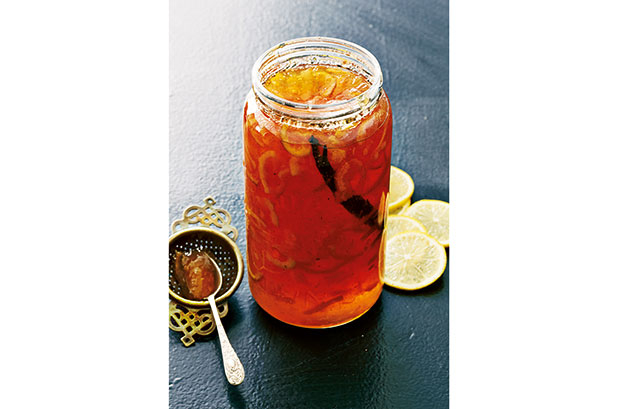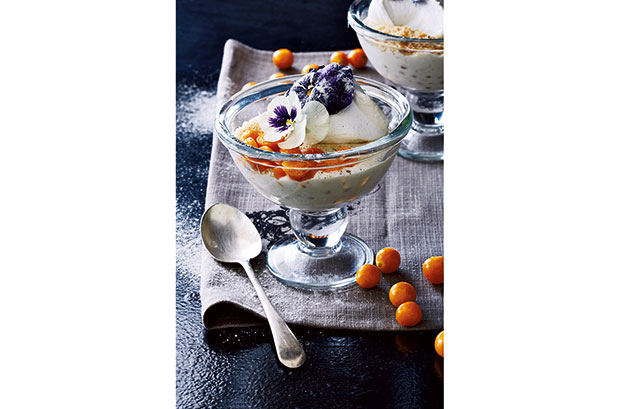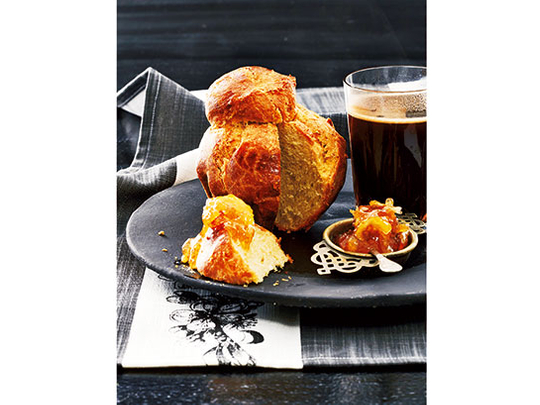
Two ways with brioche dough
Prep time overnight
Makes 2 loaves of brioche
or a batch of doughnuts
For the brioche dough
500g flour
2 tsp salt
10g instant yeast
70ml hot milk
6 eggs
350g butter
30g vanilla sugar
To make the dough, sift the flour and salt into the bowl of an electric mixer. Make a well in the centre and add the yeast and hot milk. Leave for 3 minutes or until the yeast foams.
Attach the dough hook to the mixer, add the eggs to the flour and mix at high speed for 10 minutes. Meanwhile, cream together the butter and vanilla sugar.
After 10 minutes of the mixing add the creamed butter a spoonful at a time. Mix well after each addition.
Continue mixing for 5 minutes or until all the butter has been used. Remove the bowl from the mixer and cover with greased cling film. Leave the dough to rise in a warm place for about 4 hours.
Turn out the dough on to a clean surface and knead it. Place it in a greased mixing bowl, cover again with greased cling film and refrigerate overnight.
For the classic brioche bread
To make two loaves, turn the chilled dough out on to a lightly floured surface. Divide in half and break off a third of each piece of dough.
Shape the larger portion into a ball and place in a buttered brioche pan. Make a deep recess in the middle, shape the smaller amount of dough into a ball and put it on top of the bigger one. Place in a warm spot to double in volume, about 30 minutes. Preheat the oven to 200°C. Brush the dough with beaten egg and bake until done, about 45 minutes. Test by tapping the base of the loaf – if it sounds hollow, it’s cooked.
Reduce the oven temperature to 180°C for the last 20 minutes if the loaf is browning too quickly.
For the brioche doughnuts
Divide the dough into lemon-size balls. On a floured surface, press the balls into 1.5cm thick discs.
With a 10cm round cookie cutter, neaten the discs to a uniform size then use a 1.5cm round cutter to make a hole in each.
Roll the dough removed from the holes into a balls and set aside. Carefully arrange the doughnuts on a greased baking tray and let them rest for 20 minutes, allowing them to puff up slightly. Deep-fry the doughnuts and balls in hot oil (at 180°C, if you have a thermometer or drop a piece of bread in the oil – if it sizzles and rises to the surface immediately turning golden brown, then the oil is ready) in batches. Roll the doughnuts in vanilla sugar while they are still hot. Or you can mix 150ml icing sugar with 1 tsp vanilla essence and enough water to make a runny, glossy icing to drizzle over the doughnuts.
Vanilla ice cream
Prep time 20 mins, plus freezing time
Cooking time 20 mins
Makes 1.5 litres
1 vanilla pod
1 litre milk
8 egg yolks
150g caster sugar
4 tbsp milk powder
150g liquid glucose
200g cream
Slice the vanilla pod in half lengthwise and scrape out the seeds.
In a pan, heat the seeds and pod with the milk – don’t let it boil.
Beat together the egg yolks, caster sugar, milk powder and glucose until light and fluffy.
Using a whisk, gradually add the hot milk as you whisk.
Wipe clean the inside of the milk pan with kitchen paper and pour the egg mixture back into it. Stir with a wooden spoon over medium heat.
To test if it’s ready, lift the spoon from the mixture, draw a line across the back with your finger and if the line remains distinct, it’s ready.
Pour the mixture through a sieve into a clean bowl placed over a larger bowl of iced water and stir until it has cooled slightly. Do not stop stirring, as the heat from the pan will continue to cook the custard and it can curdle.
Refrigerate the bowl until the mixture cools completely.
Stir in the cream, pour the mixture into a shallow bowl and place in the freezer.
Beat the ice cream three to four times during the freezing process. This prevents large ice crystals from forming and ensures creamy, soft ice cream.
Delicious with banana and caramel sauce.
Easy crème caramel
Prep time 15 mins
Cooking time 45 mins
Serves 4
200ml boiling water
200g caster sugar
2 eggs
Seeds from 1 vanilla pod
Salt, a pinch
385g can of condensed milk
500ml milk
Preheat the oven to 180°C. Grease 4 moulds (about 3cm deep, 150-200ml in size).
Pour the boiling water into a pan, add the sugar and stir over medium heat until it has dissolved. Now allow this to cook, without stirring, until the sugar syrup turns a golden caramel colour.
Spoon a thin layer in the bottom of each mould and leave to cool.
Beat the eggs, vanilla seeds and salt together until just combined, then gradually add the condensed milk and milk. The mixture should be smooth and there shouldn’t be too much foam on the custard.
Fill each mould by pouring the custard over the back of a spoon on top of the caramel layer until it’s about 2.5cm deep.
Place the moulds in a large ovenproof dish and pour just enough hot water into the dish so it comes to halfway up the sides of the moulds.
Bake for about 45 minutes or until just set. Remove the moulds from the water and refrigerate.
To serve, carefully loosen the edges with a blunt knife and turn out the puddings on to plates. The caramel at the bottom of the moulds will melt to form a delicious sauce.
Lemon jam
Prep time 15 mins
Cooking time 2 hours
Makes 250ml
8 medium lemons with a thin peel
1.5 litres of water
1 vanilla pod, seeds extracted
1kg caster sugar
Scrub the lemons well then dry them. Cut them, with peel, into thin slices and each slice into quarters.
Place in a large pan with the water and bring to the boil. Reduce the heat and simmer the fruit, uncovered, for about 1 hour or until the lemon peel is soft and the liquid has reduced by a third.
Add the vanilla pod, seeds and caster sugar and stir until dissolved.
Bring to the boil and simmer over medium heat for 30 minutes, or until the jam wrinkles when you drop a spoonful on to an ice-cold plate and push your finger into it. Skim off any foam from the jam and stir regularly so it doesn’t burn.
Remove the pan from the heat and skim off the last bit of foam. Pour the jam into sterilised jars and seal while hot. Enjoy on brioche with a spoonful of mascarpone.
Sago pudding with coconut
Prep time 1 hour
Cooking time 45 mins
Serves 4-6
600ml milk, plus 1 tbsp
400ml coconut milk
Salt, a pinch
1/2 cup sugar
1 cup sago, soaked in water
for 1 hour
4 tbsp butter
2 egg yolks
1 vanilla pod, seeds scraped out
1/2 cup roasted coconut
Cape gooseberries
4-6 small meringues, to garnish
Heat the milk, coconut milk, salt and sugar over low heat. Drain the sago and add to the milk. Simmer over a low heat, stirring frequently, until the sago is soft, about 30 minutes.
Remove from heat, let it cool slightly and stir in the butter.
Beat together the egg yolks, 1 tbsp milk and vanilla seeds.
Add the hot sago, a spoonful at a time, stirring continuously.
Spoon back into the pan, put the lid on and allow it to stand for 15 minutes.
Spoon the sago into bowls, garnish with roasted coconut and Cape gooseberries and top with meringue.



